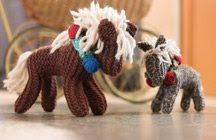
This is the Pucker-Stitch Jumper. It's definitely either vintage or vintage-inspired, and my best guess as to its provenance is that it dates from the thirties or forties. And it is an attractive design, but do be aware that it only comes in one size: tiny! The finished chest measurement is 32 inches.

This is the Myrtle-Leaf Scarf. Very pretty and delicate.

A Vintage Knitted Tie. Women used to knit such silk ties for the men in their lives. I don't know much at all about men's clothes, but I don't know whether this is something a modern man would care to wear. The shape just doesn't look current to me. If you're making this for a man and you're not the man, you'll want to clear the project with him first.

This pattern is called Naomi: An Anna Marie Jensen Doily. I don't know anyone who uses doilies, although this is certainly a beautiful one. This is a common experience for me when drooling over historical patterns: I want to make something for the sake of its beauty and historical interest, but can't come up with a use for it. And so I force myself to move on. There are plenty of patterns out there that are both beautiful and useful.

Jack Frost Baby Cardigan. This isn't a stunning pattern, but it's attractive enough and perfectly practical.

These Waldorf-Inspired Toy Horses are quite cute. I don't know if I'd want to make the rose garlands for these horses as I don't think they add anything.

An Aran for Füles. Classic Aran baby sweater. I don't know what Füles means, and a Google search told me only that it's a Hungarian word meaning "eared; having ears", and that apparently it's the Winnie the Pooh character Eeyore's Hungarian name. I don't think that's why this sweater is named what it is, unless those ear sleeves rather than arm sleeves. Füles is also a last name, so the sweater is probably just named after someone in particular. The Google searches writing for this blog send me on!

Olga's Learning Socks. These are Latvian socks. I like the concept of fancy tops on socks; they're a way of getting to wear special socks without falling into a common knitter's pitfall: being a knitter whose proudly worn handmade clothes don't match at all.

Grandmother's Finnish Socks. Pretty tops on these socks. They look kind of shapeless, but then socks always do in photos when they aren't being modelled.

Grandfather's Stockings. I don't know any grandfathers who would wear these stockings. They look like kneesocks for a girl or a woman.

These Nordic Mittens for Baby are quite cute and simple. I'd whip up a matching hat to go with them.

Miniature Sion Bag. This little bag was based on a design from the 14th century. I don't know what use a 14th-century woman would have put it to (it's not like she had a compact and lipstick to stash away), but this looks like a little girl's purse to me.

Ancient Riga Mittens. These Latvian mittens are made in a man's size, and they're very nice in their way, but I don't know how many non-Latvian men would want to wear them.

These Latvian Usinš and Sun Mittens are very colourful and elaborately patterned, and yet there's such order and detail in the pattern that it ends up achieving that perfect balance between richly patterned and loud. Few designers can achieve that; it generally takes centuries for a pattern to evolve to that point.

These Groenlo Mittens are Dutch mittens rather than Latvian. It's amazing how the traditional knitwear designs from the different countries can be so similar, yet have such a distinctively national character.

Moose at Sundown Gloves. These gloves are Norwegian. They're the kind of thing a male knitter might happily make for himself, and a female knitter might actually have a hope of talking even a conservative man into wearing.

An Aran-Stitch Vest. I don't have to qualify my praise for this vest. It's by far the best design in this issue. The care and attention that went into designing this vest really shows; it's the most exquisitely detailed pattern I've seen in awhile. The designer managed to turn the necessary shaping at the hips into a design element. If that high crewneck won't suit you, you could scoop it away by a few inches, or turn it into a v-neck.

An Orenburg Honeycomb Lace Scarf. Simple and classic, if maybe a little on the too-generic side.

This Russian Beret doesn't look very Russian to me, but it is a nice hat. The popcorn stitch and the little tie at the side give it all the visual interest it needs, and yet it's simple enough to go with anything and you'll be able to wear it for years.

Summer Flowers Gossamer Scarf. I love the delicate lacework on this scarf, and also that it's lacy without being open lacework, because open lace is so liable to get snagged.

Elizabeth Jackson's A Stocking. Really plain, basic socks. I actually don't know why anyone would make these. If I invest the time in knitting an item, I want to have something special when I'm done — something that I can't buy readymade, and I am sure I could buy purple kneesocks if I took the trouble to look for them. The day is past when we need to spend our valuable time in making generic, utilitarian items.

These Remembrance Socks look like a pair of socks it would be worth taking the trouble to make.































